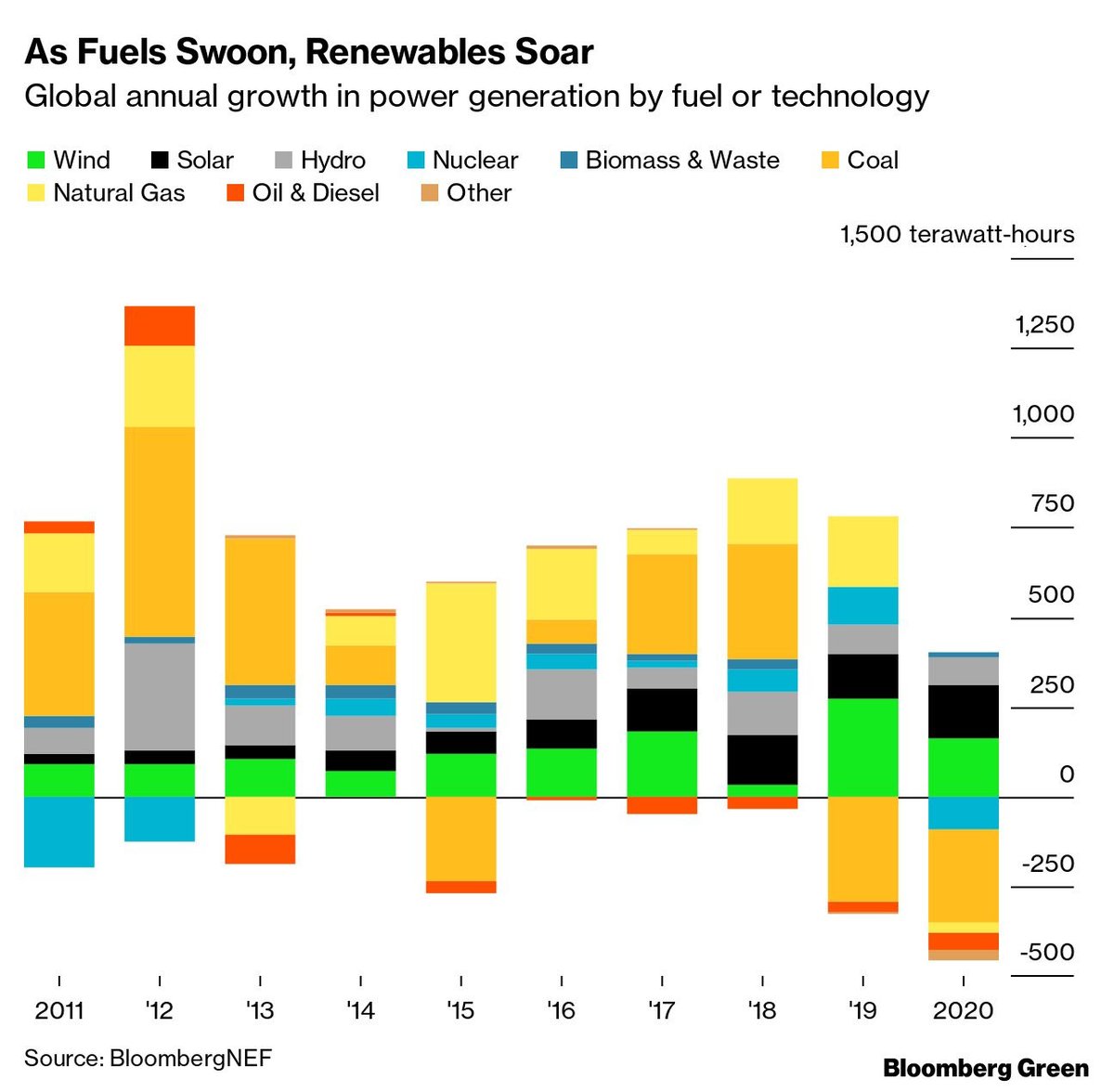
An India power challenge: how to get 400 megawatts of zero-carbon power to generate 80% of the time?
The answer: round-the-clock renewables, and batteries, and a few major changes in approach. It's another view of electricity's future, today.
bloomberg.com/authors/AQDSs6… THREAD
The answer: round-the-clock renewables, and batteries, and a few major changes in approach. It's another view of electricity's future, today.
bloomberg.com/authors/AQDSs6… THREAD
India is the world’s biggest market for renewable energy auctions, in which wind and solar project developers compete to offer the lowest possible prices for zero-carbon power. In May, India added a twist: a call for “round-the-clock” renewable power. bloomberg.com/news/articles/…
The winning bid was higher than the going rates for wind and solar in previous auctions.
It was also lower than what a number of power distributors pay for coal-fired power.
bloomberg.com/news/articles/…
It was also lower than what a number of power distributors pay for coal-fired power.
bloomberg.com/news/articles/…
It’s worth unpacking the mechanics of India's round-the-clock renewables plan, beginning with what “round-the-clock” actually means.
It’s not 24-7 renewable power generation from one project.
bloomberg.com/news/articles/…
It’s not 24-7 renewable power generation from one project.
bloomberg.com/news/articles/…
India's vision for round-the-clock renewables is a requirement to provide 400 megawatts of renewable power at least 80% of the time over the course of the year, and at least 70% of the time in any given month. bloomberg.com/news/articles/…
Wind and solar are India’s cheapest sources of renewable power, but those 70-80% capacity factor requirements are impossible to meet with one wind or solar project on its own, for two reasons. bloomberg.com/news/articles/…
The first, and pretty obvious, reason you can't get 70-80% capacity factor from wind and solar is their diurnal nature—solar doesn’t generate at night, after all, and wind generation is often low midday. bloomberg.com/news/articles/…
The second reason you can't get 70-80% capacity factor from wind and solar in India is specific to the seasonal patterns of the Indian subcontinent: mid-year monsoons, which and solar generation in different ways. bloomberg.com/news/articles/…
My @BloombergNEF colleagues have modeled the power generation from a potential site in Gujarat, in western India, and their results show the distinct difference between wind and solar generation. bloomberg.com/news/articles/… 

In Gujarat, can produce power nearly 80% of the time in May, but less than 20% of the time in November, December, and January. Solar, while steadier, generates much less for the same capacity, and also dips during monsoon season. bloomberg.com/news/articles/… 

So, how to meet the Indian government’s requirements?
1: combine resources and add batteries, which can smooth out the total capacity available from multiple technologies.
2: build more than 400 MW of wind and solar. A lot more. bloomberg.com/news/articles/…
1: combine resources and add batteries, which can smooth out the total capacity available from multiple technologies.
2: build more than 400 MW of wind and solar. A lot more. bloomberg.com/news/articles/…
.@BloombergNEF My colleagues modeled two combinations of wind, solar, and batteries that would meet India’s round-the-clock requirements. Each requires more than 1 gigawatt of total capacity. bloomberg.com/news/articles/… 

For round-the-clock renewables in western India:
Option 1: 800 MW of wind and 525 MW of solar.
Option 2: 500 MW of wind and 900 MW of solar.
Both require 1,600 megawatt-hours of batteries, which will come in especially handy during wind’s slow season. bloomberg.com/news/articles/…
Option 1: 800 MW of wind and 525 MW of solar.
Option 2: 500 MW of wind and 900 MW of solar.
Both require 1,600 megawatt-hours of batteries, which will come in especially handy during wind’s slow season. bloomberg.com/news/articles/…

Even though India’s round-the-clock auction was a first of its kind, the same competitive dynamics that define its plain-vanilla renewables auctions apply. bloomberg.com/news/articles/…
The final tariff awarded to @GoldmanSachs-backed @ReNew_Power was 19% below the opening bid. And as with every other lowest bid in previous India auctions, there will be some engineering required—financial and technical—to achieve an economic return. bloomberg.com/news/articles/…
Financial engineering strategies for India's round-the-clock renewables:
*lower IRR
*Assume falling costs for PV modules and batteries
*Project lower financing costs thanks to fiscal+monetary responses to Covid-19
*Pay occasional under-production penalties bloomberg.com/news/articles/…
*lower IRR
*Assume falling costs for PV modules and batteries
*Project lower financing costs thanks to fiscal+monetary responses to Covid-19
*Pay occasional under-production penalties bloomberg.com/news/articles/…
Technical engineering strategies for India's round-the-clock renewables:
*Use multiple sites
*Use cheap batteries with quicker replacement cycles
*(Maybe) add long-term pumped storage options
*Use advanced forecasting to better charge/discharge batteries
bloomberg.com/news/articles/…
*Use multiple sites
*Use cheap batteries with quicker replacement cycles
*(Maybe) add long-term pumped storage options
*Use advanced forecasting to better charge/discharge batteries
bloomberg.com/news/articles/…
If India’s power project developers can make round-the-clock renewables work on the business side, they’ll be an attractive option for India’s power buyers—and a challenge to coal-fired power generators. bloomberg.com/news/articles/…
There are currently three groups lined up to buy power from the round-the-clock auction winner: the New Delhi Municipal Council and two western India territories, Dadra and Nagar Haveli and Daman and Diu. bloomberg.com/news/articles/…
Currently paying:
New Delhi: 6,000+ rupees ($79.50)/MWh.
Dadra and Nagar Haveli: 4,450 rupees ($58.96)/MWh.
Daman and Diu distributor: 3,797 ($50.31)/MWh.
Round-the-clock renewables?
3,600 rupees ($47.65) per MWh bloomberg.com/news/articles/…
New Delhi: 6,000+ rupees ($79.50)/MWh.
Dadra and Nagar Haveli: 4,450 rupees ($58.96)/MWh.
Daman and Diu distributor: 3,797 ($50.31)/MWh.
Round-the-clock renewables?
3,600 rupees ($47.65) per MWh bloomberg.com/news/articles/…
India is a global model in low-cost renewable actions. Adding in extremely high capacity factors, at competitive prices to coal-fired power, is potentially game-changing.
bloomberg.com/news/articles/…
bloomberg.com/news/articles/…
• • •
Missing some Tweet in this thread? You can try to
force a refresh














